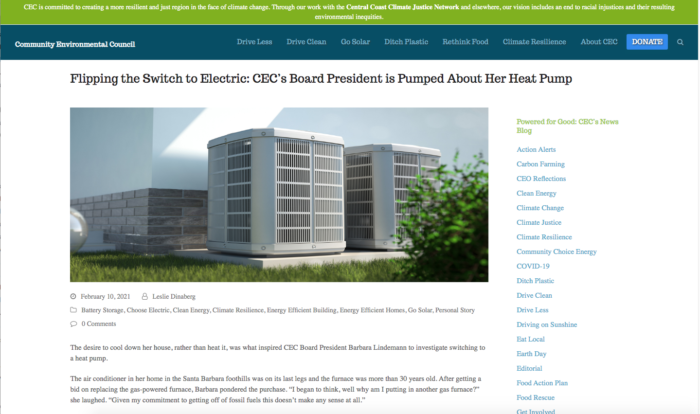The desire to cool down her house, rather than heat it, was what inspired CEC Board President Barbara Lindemann to investigate switching to a heat pump.
The air conditioner in her home in the Santa Barbara foothills was on its last legs and the furnace was more than 30 years old. After getting a bid on replacing the gas-powered furnace, Barbara pondered the purchase. “I began to think, well why am I putting in another gas furnace?” she laughed. “Given my commitment to getting off of fossil fuels this doesn’t make any sense at all.”
She asked for advice from a few knowledgeable friends, including green builder and past CEC Board President Dennis Allen and architect Dennis Thompson, who had done a remodel for the Lindemann’s a few years ago. Both of the experts agreed that heat pumps were a good alternative to another gas furnace. “Dennis Thompson pointed out that it’s not going to be long before you’re not allowed to put more gas into homes and new homes won’t be allowed to be built with gas,” said Barbara. “He said it’s really become the new thing.”
In the meantime, Barbara had also been researching getting backup batteries for her 18-year-old solar panel system. Living in a high fire zone with frequent power outages, and knowing that her solar power system would soon need to be replaced, Barbara realized that installing a heat pump would make even more economic sense when she replaced the solar with a system that included storage batteries.
Getting the heat pump “is a matter of looking to the future and taking care of our current needs at the same time,” Barbara said. While the initial upfront cost of the heat pump was slightly more than a new furnace might have been, Barbara said her gas bill has gone down and her electricity use is only up a little, “so we’re already saving money on the heat pump, even though it was more expensive to put in — and I haven’t had a chance to give it a full test with air conditioning yet.”
When summer comes around, Barbara is looking forward to her new heat pump being able to cool her home just as effectively as a standard air conditioner would, but without relying on fossil fuels to keep her family comfortable.
This story was originally published on cecsb.org on February 10, 2021.



